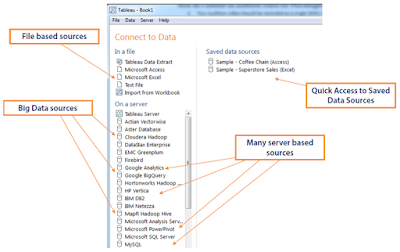Before you can build a view and analyze your data, you must first connect Tableau to your data. Tableau Desktop supports connecting to a wide variety of data, stored in a variety of places. For example, your data might be stored on your computer in a spreadsheet or a text file, or in a big data, relational, or cube (multidimensional) database on a server in your enterprise. Or, you might connect to public domain data available on the web such as U.S. Census Bureau information, or to a cloud database source, such as Google Analytics, Amazon Redshift, or Salesforce.
When you launch Tableau Desktop, the data connections that are available to you are listed on the Connect pane, which is the left pane on the Startpage. File types are listed first, then common server types, or servers that you've recently connected to. Click More Servers to see the complete list of data connections you can use. The data connections supported by your copy of Tableau Desktop are determined by the version you purchased. For more information, see the list of Data Connections on the Tableau website.
After you've connected to data sources, you can save the connections to have them show up under the Saved data sources section on the Connectpane.
You supply different information for each data connection that you want to make. For example, for most data connections, you’ll need to supply a server name and your sign-in information. With some data connections, you can Run Initial SQL statements, and SSL-enabled servers require that you select the Require SSL check box when you connect. The following sections discuss the specific information you need to provide for each data source you want to connect to.


No comments:
Post a Comment